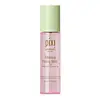What's inside
What's inside
 Key Ingredients
Key Ingredients

 Benefits
Benefits

 Concerns
Concerns

 Ingredients Side-by-side
Ingredients Side-by-side

Water
Skin ConditioningAlcohol
AntimicrobialPolyvinyl Alcohol
Ethylhexylglycerin
Skin ConditioningRosa Centifolia Flower Water
Skin ConditioningCaprylyl Glycol
EmollientPEG-60 Hydrogenated Castor Oil
EmulsifyingSodium Citrate
BufferingCentella Asiatica Extract
CleansingCamellia Sinensis Leaf Extract
AntimicrobialTrideceth-10
CleansingCaprylhydroxamic Acid
Glycerin
HumectantChamaecyparis Obtusa Leaf Extract
Skin ConditioningSoleirolia Soleirolii Extract
AntioxidantMelissa Officinalis Leaf Extract
Skin ConditioningOriganum Majorana Leaf Extract
AntiseborrhoeicParfum
MaskingButylene Glycol
HumectantBambusa Vulgaris Extract
Skin ConditioningPinus Densiflora Extract
AntioxidantThuja Orientalis Extract
AntimicrobialSalix Alba Bark Extract
AstringentOriganum Vulgare Leaf Extract
Skin ConditioningNiacinamide
SmoothingLactobacillus/Soybean Ferment Extract
Skin ConditioningCinnamomum Cassia Bark Extract
MaskingScutellaria Baicalensis Root Extract
AstringentPortulaca Oleracea Extract
Skin ConditioningMaltodextrin
AbsorbentEthyl Hexanediol
SolventCalcium Pantothenate
Sodium Starch Octenylsuccinate
AbsorbentPolyquaternium-51
Skin ConditioningSodium Ascorbyl Phosphate
AntioxidantTocopheryl Acetate
AntioxidantPyridoxine Hcl
Skin ConditioningSilica
AbrasiveWater, Alcohol, Polyvinyl Alcohol, Ethylhexylglycerin, Rosa Centifolia Flower Water, Caprylyl Glycol, PEG-60 Hydrogenated Castor Oil, Sodium Citrate, Centella Asiatica Extract, Camellia Sinensis Leaf Extract, Trideceth-10, Caprylhydroxamic Acid, Glycerin, Chamaecyparis Obtusa Leaf Extract, Soleirolia Soleirolii Extract, Melissa Officinalis Leaf Extract, Origanum Majorana Leaf Extract, Parfum, Butylene Glycol, Bambusa Vulgaris Extract, Pinus Densiflora Extract, Thuja Orientalis Extract, Salix Alba Bark Extract, Origanum Vulgare Leaf Extract, Niacinamide, Lactobacillus/Soybean Ferment Extract, Cinnamomum Cassia Bark Extract, Scutellaria Baicalensis Root Extract, Portulaca Oleracea Extract, Maltodextrin, Ethyl Hexanediol, Calcium Pantothenate, Sodium Starch Octenylsuccinate, Polyquaternium-51, Sodium Ascorbyl Phosphate, Tocopheryl Acetate, Pyridoxine Hcl, Silica
Water
Skin ConditioningButylene Glycol
HumectantPEG-50 Hydrogenated Castor Oil
EmulsifyingPhenoxyethanol
PreservativeAloe Barbadensis Leaf Juice
Skin ConditioningCaprylyl Glycol
EmollientDisodium EDTA
Sodium Citrate
BufferingTocopheryl Acetate
AntioxidantPropylene Glycol
HumectantAmp-Acrylates/Allyl Methacrylate Copolymer
Parfum
MaskingHamamelis Virginiana Leaf Extract
Skin ConditioningCitric Acid
BufferingChamomilla Recutita Extract
Skin ConditioningPotassium Sorbate
PreservativeSodium Benzoate
MaskingHydroxyapatite
AbrasiveWater, Butylene Glycol, PEG-50 Hydrogenated Castor Oil, Phenoxyethanol, Aloe Barbadensis Leaf Juice, Caprylyl Glycol, Disodium EDTA, Sodium Citrate, Tocopheryl Acetate, Propylene Glycol, Amp-Acrylates/Allyl Methacrylate Copolymer, Parfum, Hamamelis Virginiana Leaf Extract, Citric Acid, Chamomilla Recutita Extract, Potassium Sorbate, Sodium Benzoate, Hydroxyapatite
 Reviews
Reviews

Ingredients Explained
These ingredients are found in both products.
Ingredients higher up in an ingredient list are typically present in a larger amount.
Butylene Glycol (or BG) is used within cosmetic products for a few different reasons:
Overall, Butylene Glycol is a safe and well-rounded ingredient that works well with other ingredients.
Though this ingredient works well with most skin types, some people with sensitive skin may experience a reaction such as allergic rashes, closed comedones, or itchiness.
Learn more about Butylene GlycolCaprylyl Glycol is a humectant and emollient, meaning it attracts and preserves moisture.
It is a common ingredient in many products, especially those designed to hydrate skin. The primary benefits are retaining moisture, skin softening, and promoting a healthy skin barrier.
Though Caprylyl Glycol is an alcohol derived from fatty acids, it is not the kind that can dry out skin.
This ingredient is also used as a preservative to extend the life of products. It has slight antimicrobial properties.
Learn more about Caprylyl GlycolParfum is a catch-all term for an ingredient or more that is used to give a scent to products.
Also called "fragrance", this ingredient can be a blend of hundreds of chemicals or plant oils. This means every product with "fragrance" or "parfum" in the ingredients list is a different mixture.
For instance, Habanolide is a proprietary trade name for a specific aroma chemical. When used as a fragrance ingredient in cosmetics, most aroma chemicals fall under the broad labeling category of “FRAGRANCE” or “PARFUM” according to EU and US regulations.
The term 'parfum' or 'fragrance' is not regulated in many countries. In many cases, it is up to the brand to define this term.
For instance, many brands choose to label themselves as "fragrance-free" because they are not using synthetic fragrances. However, their products may still contain ingredients such as essential oils that are considered a fragrance by INCI standards.
One example is Calendula flower extract. Calendula is an essential oil that still imparts a scent or 'fragrance'.
Depending on the blend, the ingredients in the mixture can cause allergies and sensitivities on the skin. Some ingredients that are known EU allergens include linalool and citronellol.
Parfum can also be used to mask or cover an unpleasant scent.
The bottom line is: not all fragrances/parfum/ingredients are created equally. If you are worried about fragrances, we recommend taking a closer look at an ingredient. And of course, we always recommend speaking with a professional.
Learn more about ParfumSodium Citrate is the sodium salts of citric acid. In skincare, it is used to alter pH levels and acts as a preservative.
Its main functions are to maintain the pH of a product and neutralize metal ions.
The acidity of our skin is maintained by our glands and skin biome; normal pH level of skin is slightly acidic (~4.75-5.5).
Being slightly acidic allows our skin to create an "acid mantle". This acid mantle is a thin barrier that protects our skin from bacteria and contaminants.
Learn more about Sodium CitrateTocopheryl Acetate is AKA Vitamin E. It is an antioxidant and protects your skin from free radicals. Free radicals damage the skin by breaking down collagen.
One study found using Tocopheryl Acetate with Vitamin C decreased the number of sunburned cells.
Tocopheryl Acetate is commonly found in both skincare and dietary supplements.
Learn more about Tocopheryl AcetateWater. It's the most common cosmetic ingredient of all. You'll usually see it at the top of ingredient lists, meaning that it makes up the largest part of the product.
So why is it so popular? Water most often acts as a solvent - this means that it helps dissolve other ingredients into the formulation.
You'll also recognize water as that liquid we all need to stay alive. If you see this, drink a glass of water. Stay hydrated!
Learn more about Water